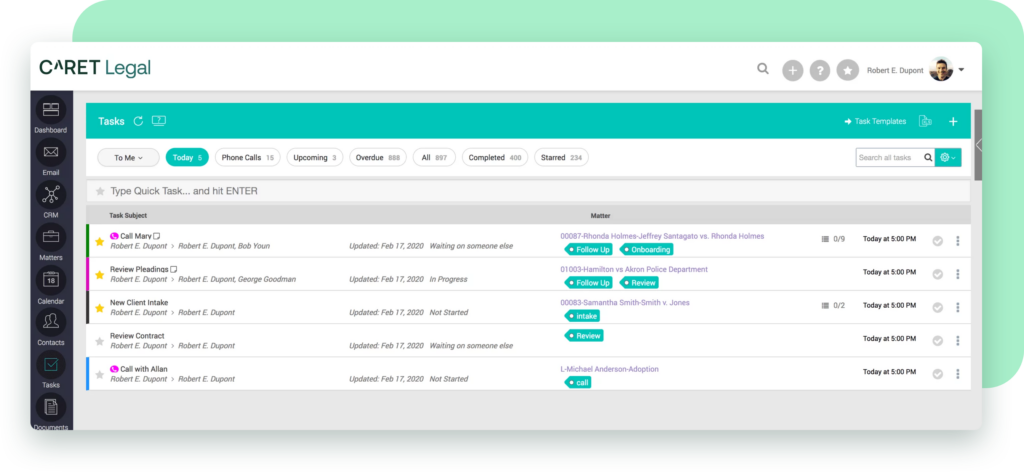Legal workflow automation brings efficiency, standardization, and improved client service to your firm.
Implementing legal workflow automation eliminates the time burden of manual task completion and promotes consistency. Task management and tracking become more effective, compliance and risk mitigation are improved, client satisfaction is enhanced through streamlined processes and transparency, and data analysis and reporting provide valuable insights. It brings efficiency, standardization, and improved client service to your firm.

Automated tasks prevent important action items from slipping through the cracks
Getting Started with Legal Workflow Automation
When implementing legal workflow automation in your practice, you first need to consider what areas need improvement.
Efficiency
The primary goal of automating your legal workflows is to eliminate manual, repetitive tasks and streamline processes. This saves time and effort for attorneys and staff, allowing them to focus on higher-value tasks that increase overall efficiency.
Consistency and Standardization
By automating legal workflows, firms can ensure consistency and standardization in their processes. This reduces the risk of errors, improves quality control, and enhances the overall delivery of legal services.
Task Management and Tracking
Automatic workflow systems enable firms to assign and track tasks more effectively. Attorneys can automatically create tasks and calendar events, assign the appropriate team member, and track their progress against deadlines.
Compliance and Risk Mitigation
Automatic workflows help ensure compliance. By incorporating compliance checks and approvals into the workflow, firms can mitigate risks and avoid potential errors or oversights.
Client Satisfaction
By streamlining processes, reducing delays, and providing transparency into case progress, firms can deliver a more efficient and responsive service to clients.
Automating workflows reduces the risk of errors, improves quality control, and enhances the overall delivery of legal services.
Choosing The Right Software
Selecting the right legal workflow automation software (usually part of a legal practice management platform) is simpler when you can identify the areas of your firm that can benefit from automation, such as deadline tracking and accounting/bookkeeping.
Deadline Tracking
Deadline tracking is a great place to start with automation. Rules-based calendaring automatically enters critical deadlines into the firm’s calendar and updates them if key dates change, eliminating the need for the manual calculation of deadlines. These tools also offer unlimited accessibility from any location to ensure that attorneys can be connected outside the office, meet the statutory deadlines of their jurisdiction, and avoid legal malpractice claims that often arise due to missed deadlines.
Accounting and Bookkeeping
Accounting for law firms is complex and time-consuming. However, legal workflow automation software simplifies the process and provides real-time visibility. These solutions eliminate the need for external accounting applications, allowing firms to get paid faster. Billing software for attorneys offers features like creating and approving bills on the go, processing electronic payments, and following up on past due accounts. It also generates audit trails and facilitates tracking changes during the billing process.
Implementing Workflow Automation at Your Firm
Finding automation opportunities is one thing, but implementing them is a different challenge. Follow these steps to make it easier for your firm to get used to automated processes.
- Plan for Implementation: Develop a detailed implementation plan. Define timelines, allocate resources, and communicate with your team about upcoming changes.
- Customize Workflows: Tailor the automation tool to match your firm’s specific processes. Configure workflows, document templates, and task assignments to reflect your firm’s unique requirements.
- Train Your Team: Provide comprehensive training to your staff on how to effectively use the automation tool. Highlight the benefits it brings and address any concerns or questions they may have.
- Start with Pilot Projects: Begin implementing automation on a smaller scale, such as a specific practice area or client type. Monitor the results and gather feedback to fine-tune the workflows before scaling up.
- Monitor and Evaluate: Continuously monitor the effectiveness of the automated workflows. Gather feedback from your team and make necessary adjustments to optimize the processes further.
- Foster Adoption and Continuous Improvement: Encourage your team to embrace the automation tool and provide ongoing support. Regularly review and refine your workflows to ensure they align with your firm’s evolving needs.
Ready to say goodbye to time-consuming tasks? Contact us for more information on the automated workflow capabilities of CARET Legal today.
